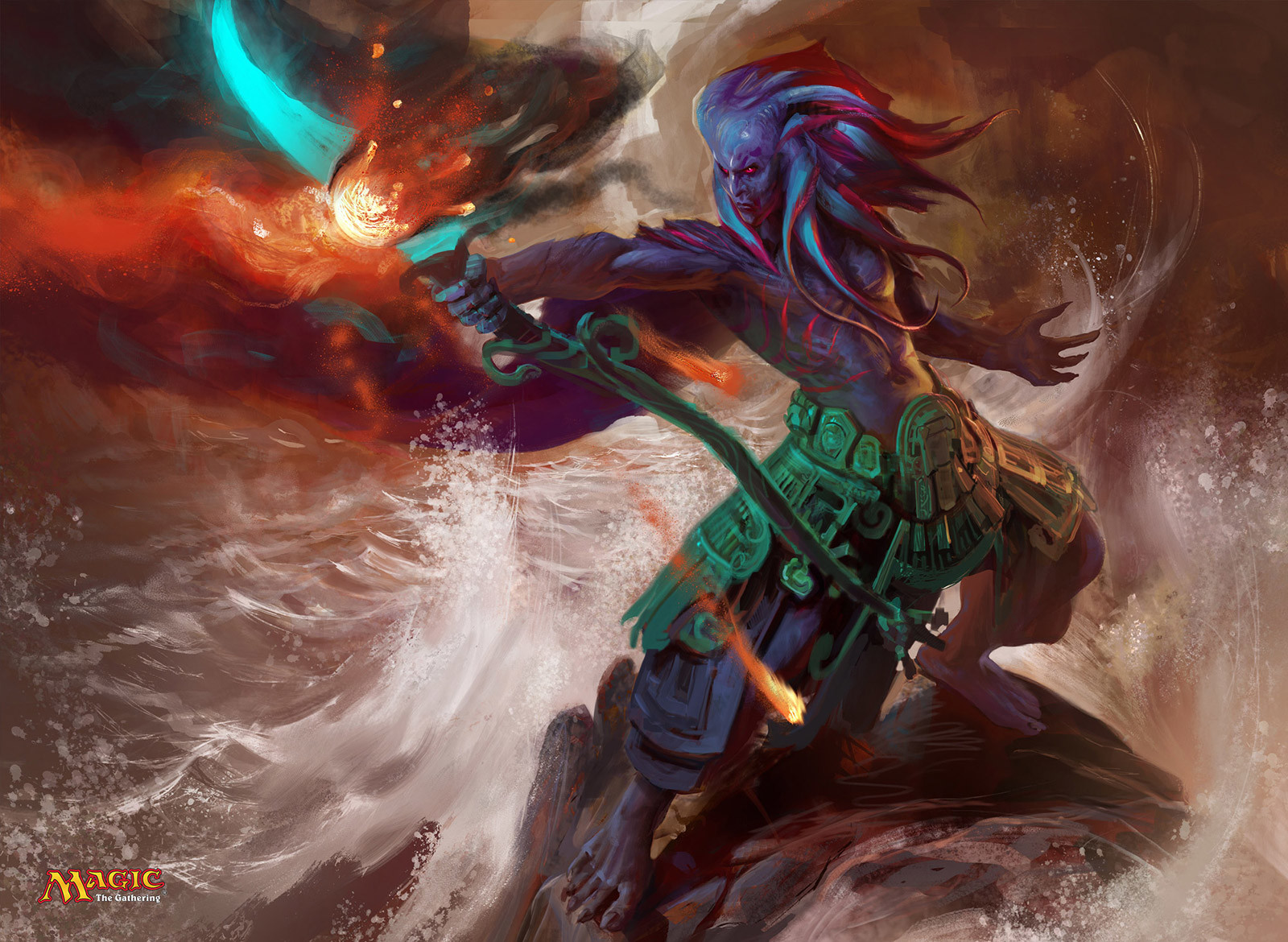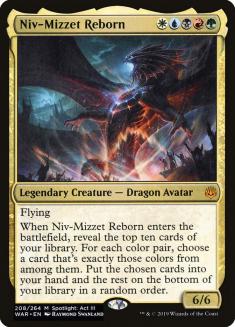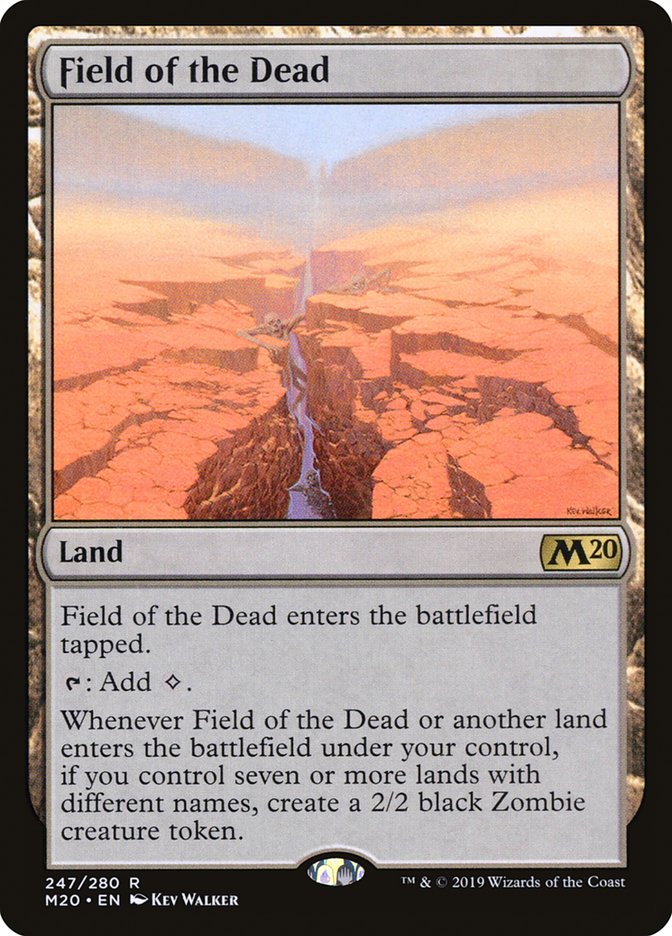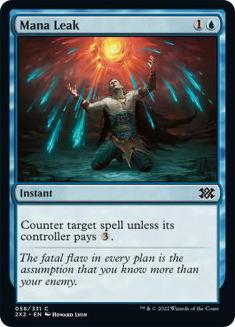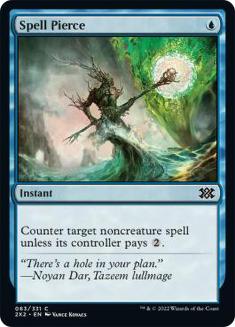Welcome to another edition of Fact or Fiction! Today, Bryan Gottlieb, Michael Majors, and Ari Lax are here to give their takes on five statements about various areas of Magic. Don’t forget to vote for the winner at the end!
1. Izzet Aggro is a serious contender in Core Set 2021 Standard.
Bryan Gottlieb: Fiction. I wrote in my article this week that Izzet Aggro felt “close” to being a contender. Unfortunately, we all know that close only counts in horseshoes and United States presidential elections. Izzet Aggro is Magic from the old times. Watching Masaru Abe play this past weekend, it was clear that the optimal games for their deck were top tier. But I also watched Abe suffer through a lot of sub-optimal games.
Izzet Aggro feels like it needs to make its first three land drops 100% of the time, can occasionally convert a fourth land into something valuable, and loses on the spot when a fifth land is drawn. There’s just not a number of lands that can routinely achieve those goals. In eternal formats, you’d make it all work with powerful cantrips. In Standard, you settle for Opt and Crash Through.
Meanwhile, 27-28 land decks have such powerful catchup mechanisms that they get to guarantee participation in every single game of Magic. In the olden days of 2019, Magic’s mana system got to function as the ultimate limiter of a deck’s upper range. Decks still needed land drops to function, and the percentage of games where mana was an issue assured that win rates for the best decks stayed in a range where other choices presented at least the illusion of viability. If you take away these constraints and combine with the London mulligan, you start seeing outliers like the 60% win rate that Sultai Ramp posted this past weekend.
This isn’t to say you must play 28 lands to win… just that it’s a lot easier to do so consistently. If you’re choosing to reinvest some of your win percentage back into manabase roulette, you have to demand some clear advantage against the expected field in return. I just don’t see that advantage materializing for Izzet Aggro.
Michael Majors: Fiction. Despite on some level the scoreboard — given a Top 8 in our previous SCG Tour Online Championship Qualifier and a win at the recent Red Bull Untapped International Qualifier — reflecting that Izzet Aggro can compete, I have to disagree given my personal experience.
The successful versions of Izzet Aggro are hyper-aggressive twenty land decks that have gone as far to include pump spells like Samut’s Sprint and Riddleform. Now there’s nothing inherently wrong with a strategy that is built around generating a couple of 3/3 flyers by Turn 3, but what holds the deck back for me is how fickle your mana is.
You have to play 4 Temple of Epiphany for color source reasons but your deck needs to curve out and can’t afford to flood. Simultaneously your mana is pressured by having and needing to cast a bunch of cheap spells in rapid succession that are fairly equally split between blue and red mana. You can develop too slowly, get mana screwed, draw too many lands, or be stuck with a single colored source and be choked on casting multiple spells in a turn.
It’s a nightmare.
A deck like Gruul Aggro on the other hand can at least afford to play those Temples because it wants to hit its fourth land drop and can easily operate with five or six lands.
The sandbox of available options for Izzet is large enough that I believe there’s a successful deck in the environment, I just don’t want to live or die on curving out every game given the mana situation.
Ari Lax: Fact. As much as any deck without Uro, Titan of Nature’s Wrath can be a serious contender anyways. OppoMTG, the player who has been grinding the deck out since early in the post ban formats, is someone I know from Grand Prixs going back a while and definitely on the list of people whose opinion is worth considering. Izzet has a lot of other stuff going for it as well: it dodges Extinction Event fairly well, has a decent interaction spread, and can itself take advantage of different roles in different matchups. That last one is key as long as we are playing open decklists and London mulligan.
Of course, Oppo also switched to Sultai Ramp this week so again, the caveat of “the best of the decks squabbling for Tier 2 supremacy while Uro wins all the trophies” applies.
2. Five-Color Niv-Mizzet is the best deck in Pioneer.
Bryan Gottlieb: Fiction. Five-Color Niv-Mizzet is a very good Pioneer deck. It was particularly good at exploiting the decks that came to prominence immediately following the most recent wave of bans. With combo out of the way, a lot of midrange decks started thinking it was their time to shine, but Five-Color Niv-Mizzet punishes the heck out of decks with the audacity to attempt that style of play. It’s the midrange mirror killer.
This means Five-Color Niv-Mizzet presently stands atop the format as the best midrange deck. That alone isn’t enough to grant it the title of best deck though, because Pioneer is actually *gasp* balanced. I know it feels like a while since we’ve had a format we can say that about, but it really is the case here. I’d argue that Mono-Green Devotion, Jund Sacrifice, Temur Reclamation and even Azorius Control can all put in reasonable claims to being the best deck for a given tournament, and there’s a robust Tier 2 that goes even deeper.
Just look at this week’s Pioneer What We'd Play . That’s seven different options from seven very smart content creators, and each one of them makes a compelling case. Five-Color Niv-Mizzet is a solid choice, but best deck is a title still up for grabs.
Michael Majors: Fiction. The card quality of Five-Color Niv-Mizzet is undeniably extremely high. It is a five-color deck after all, but it just doesn’t have any of the makings of a “best deck.”
At its core, Five-Color Niv-Mizzet is a glorified midrange deck with a light tutor package and two powerful options for playing deep games — the namesake itself and Uro, Titan of Nature’s Wrath. While it has access to strong disruption options, the need for casting those spells early is at odds with a mana base that can be slow and is not always reliable.
In a format where there are a variety of extremely strong linear strategies — Devotion, Tribal Aggro, Lotus Field, Naya Winota, and Wilderness Reclamation to name a few — Five-Color Niv-Mizzet doesn’t have that clear punch of having an unassailable engine or a powerful goldfish draw.
In my eyes it isn’t even clear if it is a stronger midrange deck than Sultai. Sure, it’s splashier, and when you’re doing your thing you’ll generate a heap more of advantage in the short term with Niv-Mizzet Reborn, but Sultai also has Uro, a bullet package with Traverse the Ulvenwald, and can actually reliably interact on the first turn with Thoughtseize and Fatal Push.
Ari Lax: Fiction. I think Five-Color Niv-Mizzet is Tier 1 and easily in the Top 3 or Top 5 decks in the format, but I think that top slot goes to Mono-Green Devotion, specifically the now stock twelve planeswalker, full wishboard list with Karn, the Great Creator and Vivien, Arkbow Ranger
Five-Color Niv-Mizzet is extremely adaptable, but also inherently exploitable. It’s a midrange deck that’s very good at generating overwhelming amounts of cards, tutoring up the right interaction, and making large threats, but that all starts around Turn 4 or Turn 5. It got comboed right out of the format the last six months, and equivalent things can happen to it again. The planeswalker Mono-Green Devotion deck stood up to Dimir Inverter on raw power, and with the added consistency of Oath of Nissa only gets even better. The impressive part is how good some of the games you aren’t all-in on devotion or Turn 3 Nissa are. The fail case is Turn 3 Vivien or Karn threatening the same game-changing tutor effect Bring to Light offers the Niv-Mizzet deck.
Why choose to give up proactive speed and power for versatility when you can have it all?
3. It’s time to ban (or suspend) Field of the Dead in Historic.
Bryan Gottlieb: Fact. I’m not sure how you can present an argument that Field of the Dead is a negative influence on Pioneer and a positive influence on Historic. Field’s existence eats up a lot of oxygen in the room, and it invalidates most other end-games. The twelve Explore, 30-land builds are floating into a space that only slightly resembles Magic. People do not like losing to the card.
Field of the Dead is a mistake. I am completely fine with it being acknowledged as such, and unprinting it from the game. I think it’s a clear example of why formats need stated goals to drive their banned lists. If we’ve decided that this mode of gameplay is fine here but out of bounds in Pioneer, point to some principle that explains why. Otherwise its hard to see Field of the Dead’s presence in the format as anything more than an oversight.
Michael Majors: Fiction. I’d abstain here if that was a valid choice in the exercise, but given that it isn’t: Fiction with the caveat of “it isn’t time yet.”
There are some things about Field of the Dead I like: it basically eliminates the possibility of do-nothing control from being the best deck in the environment, it is fairly exploitable (for now!), and it creates some interesting incentives in the format for different cards to show up.
Now, one could easily argue that the cons vastly outweigh this: A no-mana investment inevitability engine isn’t exactly the most engaging Magic, it is possible for this engine to slot into too many decks, and the more powerful these decks get the stronger they get at locking down the combat step except for through flying, but again it is a matter of timing.
Explore and Hour of Promise were huge picks up in recent printings to linear Field decks, and I don’t think we’ve had enough time to fully appreciate if the latter is too much of a power injection, especially when Historic has received a major facelift with the printing of Amonkhet Remastered.
The issue I foresee is when Field of the Dead can just package together all the best disruptive and anti-combo elements — Thoughtseize and Pact of Negation — and be a full blown monster that can spend its mana stopping an opponent since all they need to do to win the game is play lands. Pact of Negation in particular is the card that makes me the saddest to see out of AKH, a card only used for evil.
To be direct — I have little doubt that Field of the Dead will eventually have to go, but I’d prefer that formats get a little bit more time to be explored before being shaken up so aggressively.
Ari Lax: Fact. Wizards of the Coast suspended Field of the dead half a year ago. They then decided it was totally fine and unsuspended it. The only excuse I can think of was they thought their random addition of Goblin Ruinblaster or Ghost Quarter to the format was enough, and uhhh…..
Field of the Dead is banned in Standard and Pioneer, among the better plans in Modern, and unplayable in Legacy. It’s banned because of a combination of being too powerful, too oppressive to midrange and control, and simply miserable to play mirror matches of. In Pioneer it was mostly used with Hour of Promise that just got added to Magic Arena.
There’s no Historic data because Arena doesn’t have regular real tournaments in client, so who knows what is even the truth of that format. I also don’t know what the intended power level of the format is, or if WotC even has an idea of what they want the format to be. But all the signs point to wondering why the card is still in the format, and wondering why it didn’t just stay gone the first time.
4. WotC should consider moving cards like Mana Leak and Spell Pierce to white to buff its share of the color pie while still playing into its “taxing” identity (question inspired by Simon Nielsen)
Bryan Gottlieb: Fiction. I have no reasonable response to this question. I have played Magic since 1994. Counterspells are blue. Get off my lawn and turn your music down. Thank you.
Michael Majors: Fiction. How does this make the game more fun? If suddenly my Azorius Control opponent is spending their white mana for their Mana Leak it’s somehow forgivable?
The good faith response: agonistic of the power level of the cards, these taxing elements are a lot more fun when they require some investment and have a greater sense of interactivity. Thalia, Guardian of Thraben is a wildly powerful card, but is a good design that feels very white.
In particular, the symmetric nature (“rules setting” as we referred to it internally sometimes) on many of these effects is key, especially if they don’t require giving up the card investment. Further, white’s identity is tied to high creature counts and a lack of permanency when it comes to answering a variety of threats (see Banishing Light) so it doesn’t make a lot of sense to just be able to answer anything from hand no questions asked. “Your opponent must pay 3” doesn’t do enough to unblur the lines between white and blue.
Ultimately, I think leaning more into Judge’s Familiar and similar designs is probably a good way to hook into white’s strengths (small creatures, effective but short term taxing and advantages) that is color pie appropriate and also fleshes out one of their primary identities beyond just linear “go-wide” aggro.
Ari Lax: Fiction. First off, white’s taxing identity is related to its general symmetrical rules setting ability dating back to Armageddon and Wrath of God. The exceptions to symmetry are often related to outside flavor, like Tithe Taker being specifically Orzhov.
Second, I don’t think that solves any core color role issues with white. Those cards would just find their way into Mono-White Aggro decks, and you then have the issue where if you push the actually good one- and two-drops your white Mana Leak makes the deck too good and wham, right back to current white’s issues. Or yet again white becomes the token generic removal color in another midrange deck. What white needs is another legitimate proactive plan that isn’t Savannah Lions or a four-mana planeswalker.s
Third, I think reducing those options in blue leads to significantly worse gameplay there. Blue is currently locked between efficiency without versatility, like Negate or Essence Scatter, versus inefficient generic answers, like Sinister Sabotage. Games where just those cards are legal come down to land drops too often and players being stuck in scripted inaction or action points. The existence of Mystical Dispute and Spell Pierce make things way more dynamic with decisions about going now, waiting, and exact mana counts really mattering.
I’ll take Mana Tithe though, if only just to teach kids these days a bit of respect.
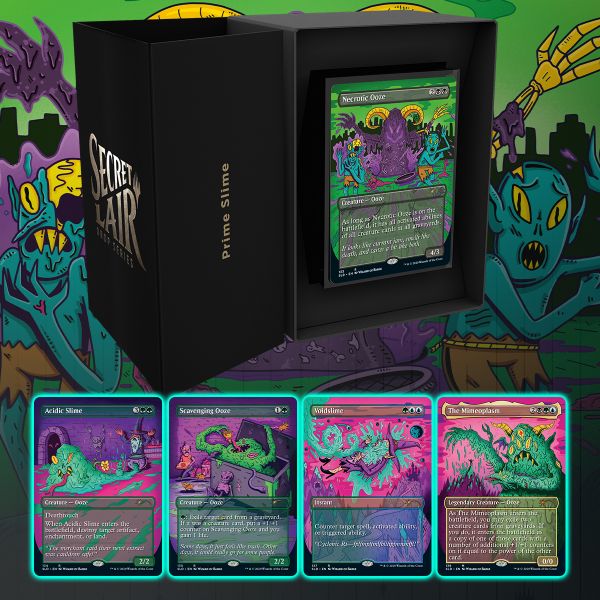
5. You’re excited about Secret Lair: Prime Slime.
Bryan Gottlieb: Fiction. Necrotic Ooze is one of my favorite Magic cards of all time. I love foils and extended frames. I buy a lot of Magic cards. I buy a lot of the random direct offerings that WotC sells. I have SDCC planeswalkers. I have a My Little Pony boxed set. I have never bought a Secret Lair.
Something about the whole thing just feels off to me. Besides the reclamation of business from the stores that have been the lifeblood of Magic for decades, there is also an element of variant fatigue setting in.
Before I found Magic, my two biggest hobbies were collecting sports cards and comic books. During the 90’s both of those industries discovered the selling power of variant printings. At first, rare collector’s editions of cards and comics fueled massive sales booms. People didn’t want to miss the next Action Comics #1 or Mickey Mantle rookie card. After being told that everything was a super scarce limited edition, speculators and casual fans alike overbought, horded, and waited for the profit to roll in, proudly displaying their very rare things that everyone else also had purchased in bulk. Unsurprisingly, plans didn’t pan out, and both industries were brought to the brink of financial ruin.
I think the inherent value of Magic cards as game pieces provides some insulation to this type of catastrophe. I’ve remarked that if Magic cards were worthless, I’d certainly buy them all… which is decent evidence that it’s hard for them to be worthless. Still, I can’t ignore the parallels here. There are just too many Magic cards being made, and I’m not going to allow myself to be roped in to purchasing all of them because I’m afraid of missing out.
Add in routine Secret Lair shipping delays, stories of cards shipping in a damaged state, and the difficulty of actually accumulating playsets of the cards I want without buying a bunch of cards I don’t and I’m just off the product line in general.
Michael Majors: Fiction. I kind of want to answer fact so I don’t look so negative today, but no reason to lie about it.
This art style just isn’t for me. I dig a lot of the super surreal stuff that’s popped up in Secret Lair, and in general I love the “semi-grounded in realism” approach to the surreal like Seb Mckinnon’s work.
The Adult Swim-like cartoon ooze monsters though? I can leave it.
Ari Lax: Fiction. Secret Lair isn’t for me. I think some of the alternate arts are cool, but my aesthetic is more Magic 2011 Lightning Bolt that just says “Deal 3 damage to any target” and skips the flavor text or fancy stuff. Just clean, simple. Or maybe it’s more “every single Thoughtseize has the same game text so who cares”.

